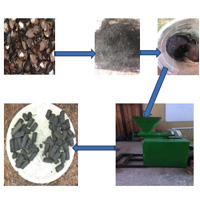Development and evaluation of biomass-based alternative charcoal

Published: 29 September 2020
Abstract Views: 1680
PDF: 750
HTML: 375
HTML: 375
Publisher's note
All claims expressed in this article are solely those of the authors and do not necessarily represent those of their affiliated organizations, or those of the publisher, the editors and the reviewers. Any product that may be evaluated in this article or claim that may be made by its manufacturer is not guaranteed or endorsed by the publisher.
All claims expressed in this article are solely those of the authors and do not necessarily represent those of their affiliated organizations, or those of the publisher, the editors and the reviewers. Any product that may be evaluated in this article or claim that may be made by its manufacturer is not guaranteed or endorsed by the publisher.
Similar Articles
- Domenico Pessina, Davide Facchinetti, Valentina Bonalume, Evaluation of the efficiency of systems to reduce vibration on modern tracklaying tractors , Journal of Agricultural Engineering: Vol. 43 No. 1 (2012)
- Maria Lisa Clodoveo, Tiziana Dipalmo, Cristina Schiano, Domenico La Notte, Sandra Pati, What’s now, what’s new and what’s next in virgin olive oil elaboration systems? A perspective on current knowledge and future trends , Journal of Agricultural Engineering: Vol. 45 No. 2 (2014)
- Francesco Da Borso, Alessandro Chiumenti, Maurizia Sigura, Andrea Pezzuolo, Influence of automatic feeding systems on design and management of dairy farms , Journal of Agricultural Engineering: Vol. 48 No. s1 (2017): Special Issue
- Ian Torotwa, Qishuo Ding, Emmanuel Awuah, Ruiyin He, Biomimetic tool design improves tillage efficiency, seedbed quality, and straw incorporation during rototilling in conservation farming , Journal of Agricultural Engineering: Vol. 54 No. 1 (2023)
- Meizhou Chen, Guangfei Xu, Xianghao Li, Hongda Zhao, Yongli Zhao, Peisong Diao, Yinping Zhang, Optimization design and experiment of double-helix total mixed rations preparation mixer for silage straw feed , Journal of Agricultural Engineering: Vol. 55 No. 2 (2024)
- Ernest Ekow Abano, Hai Le Ma, Wenjuan Qu, Thin-layer catalytic far-infrared radiation drying and flavour of tomato slices , Journal of Agricultural Engineering: Vol. 45 No. 1 (2014)
- Roy Latsch, Joachim Sauter, Optimisation of hot-water application technology for the control of broad-leaved dock (Rumex obtusifolius) , Journal of Agricultural Engineering: Vol. 45 No. 4 (2014)
- Simone Pascuzzi, A multibody approach applied to the study of driver injuries due to a narrow-track wheeled tractor rollover , Journal of Agricultural Engineering: Vol. 46 No. 3 (2015)
- Marzia Quattrone, Giovanna Tomaselli, Lara Riguccio, Patrizia Russo, Assessment of the territorial suitability for the creation of the greenways networks: Methodological application in the Sicilian landscape context , Journal of Agricultural Engineering: Vol. 48 No. 4 (2017)
- Giulio Senes, Natalia Fumagalli, Paolo Stefano Ferrario, Roberto Rovelli, Federico Riva, Giovanna Sacchi, Paolo Gamba, Giacomo Ruffini, Giacomo Redondi, Assessment of the ecosystem services given by rural and urban green areas to preserve high-quality territories from land take: the case of the province of Monza Brianza (Italy) , Journal of Agricultural Engineering: Vol. 54 No. 4 (2023)
<< < 3 4 5 6 7 8 9 10 11 12 > >>
You may also start an advanced similarity search for this article.

 https://doi.org/10.4081/jae.2020.1032
https://doi.org/10.4081/jae.2020.1032






